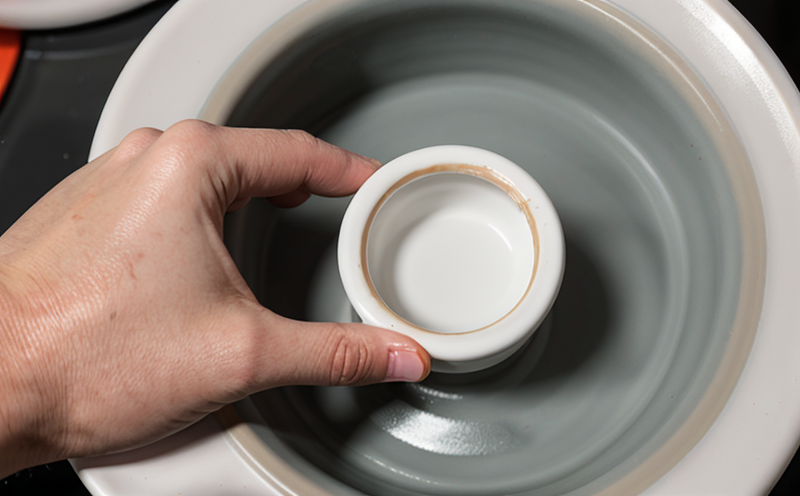ISO 23155 Pore Size Distribution of Nanostructured Ceramics
ISO 23155 is a globally recognized standard that provides a precise methodology for determining the pore size distribution in nanostructured ceramics. This test is crucial because it allows manufacturers and researchers to ensure their products meet stringent quality control standards, which are essential for optimizing performance, durability, and reliability across various industries.
The process involves several key steps: sample preparation, scanning electron microscopy (SEM) analysis, data collection, and statistical analysis using advanced software. The resulting pore size distribution profile provides insights into the microstructure of ceramics at a nanoscale level, which is critical for applications such as filtration membranes, catalysts, and ceramic coatings.
The importance of this test cannot be overstated, particularly in sectors like healthcare, aerospace, electronics, and energy storage. For instance, in medical devices, understanding pore size distribution helps in designing filters that can efficiently remove contaminants while minimizing damage to cells. In the aerospace industry, it ensures that ceramics used in high-temperature applications have optimal thermal conductivity and mechanical strength.
The test aligns with international standards like ISO 23155, which mandates rigorous procedures for sample preparation and data analysis. Compliance with these standards not only enhances product quality but also facilitates easier market entry into global markets where stringent regulations are in place.
Understanding the pore size distribution is essential for predicting the behavior of nanostructured ceramics under various conditions. This includes thermal shock resistance, mechanical strength, and chemical stability. By accurately characterizing pores, manufacturers can tailor their products to meet specific performance requirements, thereby enhancing overall product quality and customer satisfaction.
The ISO 23155 method is particularly relevant for industries where precision and reliability are paramount. The test results provide valuable data that can be used to optimize production processes, identify potential issues early on, and ensure consistent quality across batches.
In conclusion, the ISO 23155 pore size distribution test plays a vital role in ensuring high-quality nanostructured ceramics. It supports compliance with international standards, enhances product performance, and contributes significantly to customer satisfaction by delivering reliable and consistent results.
Why It Matters
The pore size distribution of nanostructured ceramics is critical for several reasons:
- Performance Optimization: Understanding the pore structure helps in optimizing performance parameters such as permeability, mechanical strength, and thermal conductivity.
- Durability and Reliability: Proper characterization ensures that products can withstand harsh environmental conditions without degradation.
- Consistency: By standardizing the test method, ISO 23155 helps maintain consistent quality across different batches and production runs.
- Regulatory Compliance: Adhering to international standards like ISO 23155 ensures that products meet regulatory requirements and can be marketed globally.
The test also supports the development of innovative materials by providing detailed insights into the microstructure, which is essential for advancing technology in sectors such as healthcare, electronics, and energy storage.
Moreover, accurate pore size distribution data allows manufacturers to make informed decisions about material selection, processing techniques, and final product design. This leads to improved efficiency, reduced waste, and enhanced overall performance of the products.
Why Choose This Test
Selecting ISO 23155 for pore size distribution testing offers several advantages:
- Global Recognition: The standard is widely accepted in the industry, ensuring that your results are credible and recognized worldwide.
- Consistency: Standardized procedures ensure consistent and reliable test results across different laboratories.
- Compliance: Compliance with ISO 23155 helps meet regulatory requirements and facilitates market entry into international markets.
- Innovation: The detailed insights provided by this test can drive innovation in material science, leading to the development of new products and technologies.
The test is particularly beneficial for R&D teams looking to push the boundaries of current technology. By providing precise data on pore size distribution, it enables them to make informed decisions about product design and manufacturing processes.
For quality managers and compliance officers, this test offers a robust framework for ensuring high-quality products. It provides clear guidelines for sample preparation and analysis, reducing the risk of errors and inconsistencies in testing.
Customer Impact and Satisfaction
The ISO 23155 pore size distribution test has significant impacts on customer satisfaction and product performance:
- Better Product Quality: By ensuring that nanostructured ceramics meet strict quality control standards, this test enhances the overall quality of products.
- Increased Reliability: Understanding the pore structure helps in designing more reliable products that can withstand various environmental conditions.
- Enhanced Performance: Precise characterization allows for the optimization of performance parameters, leading to better product functionality.
- Increased Marketability: Compliance with international standards like ISO 23155 enhances marketability and opens up new opportunities for global sales.
In addition to these benefits, the test also supports long-term customer relationships by ensuring consistent quality across different batches. This builds trust and loyalty among customers who appreciate high-quality products.
For procurement teams, this test provides valuable data that can be used to make informed decisions about material selection and supplier evaluation. It ensures that only the highest quality materials are used in production, leading to cost savings and improved product performance.





